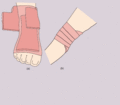Chapter 27: Living with and beyond cancer
Skip chapter table of contents and go to main content


27.13 Compression bandaging (multilayer short‐stretch): bandaging a leg and the toes
Essential equipment
- Tubular stockinette: this can be purchased in a long roll and a length cut to suit the limb size. Different widths are available
- Light retention bandages: 4‐cm width to bandage the toes, 6‐cm or 10‐cm to hold foam in place
- Synthetic orthopaedic padding rolls: 6‐cm, 10‐cm and 12‐cm width rolls to pad and reshape the limb
- Sheet of low‐density foam to cut to shape and pad out uneven areas
- Low‐stretch compression bandages, 8, 10 and 12 cm. A variety of widths is required to suit the shape of the limb
- Tape scissors
Pre‐procedure
ActionRationale
- 1.Explain and discuss the procedure with the patient.
- 2.If possible, the patient should be seated upright on a bed or treatment couch. Raise the bed or couch to a comfortable height.To ensure the comfort of both the patient and nurse. E
- 3.The swollen limb should be clean and well moisturized with a bland emollient (e.g. E45) before being bandaged.
Procedure
- 4.Cut a length of tubular stockinette long enough to fit the patient's leg. Slip over the leg.
- 5.If the toes are swollen or tend to swell, they must be bandaged. The little toe can be omitted. Using a narrow light retention bandage, anchor the bandage around the foot and bring across the top of the foot to the big toe (Action figure 5a and Figure 27.19a). Bandage around the toe from the tip downwards (start at the level of the nail bed). Do not pull the bandage tight, but proceed gently and firmly. Take the bandage under the foot and back over the top of the foot to the next toe (Action figure 5b). Repeat the same procedure for each toe that needs to be bandaged. Finish by tucking in the end of the bandage (Action figure 5c).
- 6.Foam pads can be cut to size and placed over the dorsum of the foot, around the ankle and behind the knee (Action figures 6a, 6b).
- 7.Secure the pads firmly in place with light retention bandages.
- 8.Using padding, even out any exaggerated contours of the limb. Corrugated or contoured foam can be used over areas of fibrotic tissue.
- 9.Using a 10‐cm roll of padding, apply firmly in a spiral up the leg, starting around the foot. Use the 20‐cm padding over the thigh (Action figure 9 and Figures 27.19b and c).To protect the skin and create a smooth profile on which to bandage (Quéré and Sneddon [231]).
- 10.Advise the patient to hold their foot at a 90° angle while it is bandaged. Use 8‐cm compression bandage and begin by anchoring it with a double layer wrapped around the foot close to the base of toes (Action figure 10, Figures 27.19d and e). Continue bandaging the foot firmly, forming a figure of eight to cover the heel and ankle without leaving any gaps. Any surplus bandage should be taken up the leg in a spiral.
- 11.Using a 10‐cm bandage, continue from where the first bandage finished, using a spiral up the leg and covering half of the bandage with each turn (50% overlap). Remember to bandage firmly. Use the widest bandage over the thigh. Secure the end of the last bandage with tape (Figure 27.19f).
- 12.
Post‐procedure
- 13.Check the colour and temperature of the patient's toes. It may be difficult for the patient to flex the knee at first but this should get easier as the bandages loosen slightly.
- 14.Remind the patient to use the limb as normally as possible, to exercise as advised and to remove the bandages if any pain, tingling or numbness is experienced.
- 15.Record the details of the procedure in the relevant patient documentation.

Action Figure 5 (a) A narrow light retention bandage is anchored around the foot and brought across the foot to the big toe. (b) The toes are bandaged in turn from the nail bed along the length of the toe. (c) The bandage is taken under the foot and back over the top of the foot to bandage the next toe.

Action Figure 5 (a) A narrow light retention bandage is anchored around the foot and brought across the foot to the big toe. (b) The toes are bandaged in turn from the nail bed along the length of the toe. (c) The bandage is taken under the foot and back over the top of the foot to bandage the next toe.









